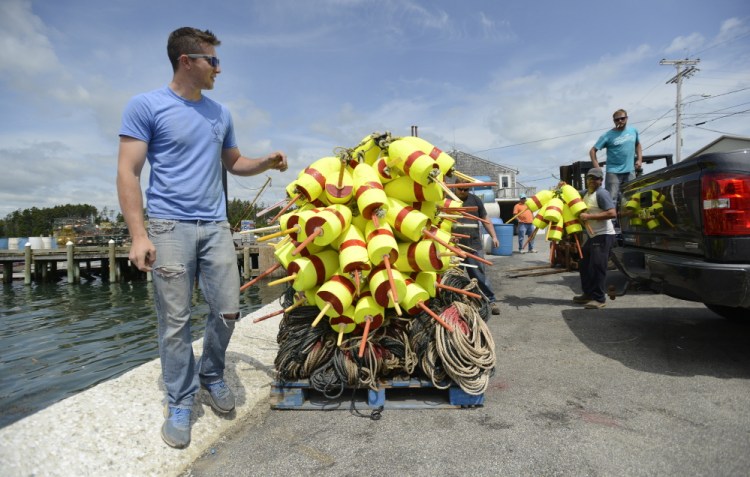Maine’s lobster industry is gearing up for another big year as the state’s 4,500 commercial fishermen wait for lobsters to migrate to the coast and shed the hard shells they’ve been carrying all winter.
And wait they must.
Fishermen and consumers probably won’t see those “shedders” until the middle of July – one to two weeks behind schedule – because of colder-than-normal water temperatures, according to scientists. The shortage has led to above-average lobster prices over the Fourth of July weekend, just when the state’s summer tourism season is coming into full swing. The Fourth of July weekend is considered the normal start date for the lobster fishery in Maine.
Fishermen who have traps in the water now aren’t catching much except for a few hard-shell lobsters, and those lobsters don’t seem eager to molt any time soon, said Peter McAleney, who runs New Meadows Lobster, a wholesaler in Portland.
“This winter has really messed us up,” he said. “The dealers and the fishermen are wondering what the heck is going to happen.”
Still, industry veterans say there’s no reason to panic. The lobsters will come again, just like they do every year, said Tom Flanigan, co-owner of Seaview Lobster Co. in Kittery.
“The old saying is: ‘The weather gets better before the lobster catch does,'” he said. “It takes awhile for the water temperatures to warm up and for the lobsters to do their thing.”
LATE START BETTER THAN EARLY
It all comes down to weather – not this weekend’s mostly sunny summer skies but the bitter cold of last winter that chilled the Gulf of Maine. Then a wave of storms in February mixed up the water column and drove those low temperatures at the surface down to lobster habitat at the bottom.
While the ocean has since warmed up, surface temperatures are in the low 50s, slightly below normal for this time of year, according to Andrew Pershing, chief scientist at the Gulf of Maine Research Institute, which this year began forecasting the start of the lobster harvest. The institute is forecasting a 43 percent chance the harvest will start a week late and a 20 percent chance it will start two weeks late.
There was a late start also in 2005. That year, total annual landings were lower than normal, and the prices paid to fishermen were a record high $4.63 per pound, according to the Maine Department of Marine Resources.
For fishermen, a late start is better than an early one. They remember what happened in 2012 when warm water temperatures caused Maine lobsters to move inshore and molt earlier than normal, kicking off the harvest three weeks early. Canadian processors were not ready for the influx. The resulting glut of supply resulted in dock prices paid to fishermen falling in some cases to below $2 a pound, and some fishermen chose to tie up their boats rather than haul traps. The average per-pound price paid to fishermen that year was $2.69.
Lobster prices are relatively high now. Fishermen are getting paid approximately $4 per pound for soft-shell and $6 a pound for hard-shell. Retailers are selling 1-pound hard-shell lobsters for between $7.99 and $10.99 in the Portland area.
The spike in lobster prices happens at this time every year when the Canadian spring lobster season winds down and the Maine season has yet to begin, said Nick Alfiero at Harbor Fish Market in Portland. That’s because demand outstrips supply, if only for a few weeks.
The Canadians target hardshell lobsters, which fetch higher prices because they can be shipped globally, and avoid molting lobsters.
Maine fishermen, who typically have smaller boats and set their traps closer to shore, target lobsters after they molt and their shells are soft. These lobsters, now being called “new shell” lobsters as part of the industry’s new marketing campaign, don’t survive when shipped long distances. That’s why they’re less expensive. But they are easier to eat, and the meat is promoted as sweeter and more tender.
The Maine fishery is the only one in the world that targets soft-shell lobsters.
“When the season hits, that’s our season. That’s how we are different, ” said Steve Train, a Long Island lobsterman. Train traveled last weekend to New York City as part of the Maine Lobster Marketing Collaborative’s effort to showcase the qualities of new shell lobsters to chefs and influential food writers.
CLASSIC CASE OF SUPPLY AND DEMAND
The Maine lobster industry has been trying to sustain lobster prices by increasing consumer demand. The newly created Maine Lobster Marketing Collaborative is spending nearly $6 million over the next three years on the industry’s first-ever comprehensive marketing effort.
In the long run, those efforts will boost prices, said Edward Grant, 59, a lobsterman from York.
“There is more of a market now, and that makes lobsters more valuable,” he said.
Many fishermen focus on the size of the catch rather than value, said Gerry Cushman, a lobsterman in Port Clyde.
“I really don’t care how many lobsters I’m going to catch,” he said. “Well, I do a little, but I’m more interested in the prices we are going to get for them.”
Cyrus Sleeper, 26, of South Thomaston said the late season bodes well for the fishery because the lobsters are in better condition when he catches them. That means higher prices, he said.
“The later they shed, the better the quality,” he said. “A lobster that looks good is a good lobster to eat.”
Attractive lobsters could take the edge off the higher prices, which are not necessarily good for consumers or restaurants. Restaurant managers must decide whether to pass on the higher prices to patrons or make less money on every dish.
Frank Sprague, owner of Sprague’s Lobster on the Main Street Pier in Wiscasset, said he’s keeping the price of a lobster roll steady, at $15.95, even though some competitors have increased their price to $19.95.
He’s paying $35 per pound for fresh-picked lobster claws, up $5 from two week ago. Normally he pays $28 per pound.
He said prices will drop once Maine lobstermen begin harvesting shedders and flood the marketplace with tens of millions of pounds of lobster meat.
“The price will come down at some point,” he said.
SIGNS OF ABUNDANCE
The supply of Canadian lobsters this spring was down because there was so much ice in the Gulf of St. Lawrence that the fishing season was delayed. It was supposed to begin on May 1, but fishermen didn’t start fishing in some areas until May 11.
There should be plenty of lobsters to catch in Maine once the shedders arrive, based on multiple sample surveys of dime-size lobster juveniles and also trap surveys of larger lobsters, said Carl Wilson, director of the Bureau of Marine Science for the Maine Department of Marine Resources.
Fishermen have been seeing a “phenomenal” amount of lobsters that are now too small to be caught legally but will become legal size after they molt and grow into their new shells, said Bob Baines, a lobsterman in Spruce Head and board member of the Maine Lobstermen’s Association. Fishermen who catch these smaller lobsters must throw them back in the water.
“All spring long we have been picking short lobsters out of the traps,” he said. “The resource is in great shape.”
That wasn’t always the case. Between the late 1940s and the late 1980s, Maine lobstermen were catching about 20 million pounds of lobsters a year, Wilson said. Since then, the annual lobster harvest has increased sixfold. Last year, fishermen harvested 124 million pounds of lobster, with a total value of $457 million.
The fishery today is among the largest in the United States.
“Right now it’s important for people to understand that it’s an unprecedented prosperity for the lobster population and the associated fishery,” Wilson said. “It’s a gift to the state of Maine.”
Send questions/comments to the editors.





Comments are no longer available on this story